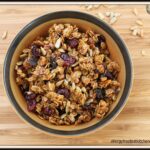Imagine a world where the chill of winter evenings is met not with shivering discomfort, but with the warm embrace of delicious, allergen-free meals. This culinary journey explores a collection of comforting recipes designed to banish winter blues while catering to dietary restrictions. From vibrant, hearty soups simmering on the stove to slow-cooked main courses promising effortless elegance, we’ll craft a winter feast that’s both satisfying and safe for those with allergies. Prepare for a visual feast, as we delve into detailed descriptions of textures, colors, and aromas, transforming each dish into a sensory experience.
This guide provides comprehensive, step-by-step instructions for creating a diverse range of allergen-free dishes, perfect for cozy winter nights. We’ll cover soups, slow cooker meals, side dishes, and even delightful desserts, all meticulously crafted to be both delicious and allergy-conscious. We’ll also offer tips for adapting recipes to various dietary needs and for creating a beautifully inviting dining atmosphere to enhance the overall experience.
Allergen-Free Slow Cooker Main Courses

Slow cookers are a wintertime lifesaver, offering comforting, flavorful meals with minimal effort. These two recipes provide delicious, allergen-free options perfect for a cozy night in, requiring minimal prep time and virtually no active cooking once started. Both recipes are easily adaptable to various dietary needs, making them versatile and inclusive.
Hearty Lentil and Vegetable Stew
This hearty stew is naturally gluten-free, dairy-free, and nut-free, making it suitable for many common allergies. The lentils provide protein and fiber, while the colorful vegetables offer essential vitamins and minerals. The slow cooking process allows the flavors to meld beautifully, creating a deeply satisfying and warming meal.
- Ingredients:
- 1 cup brown or green lentils, rinsed
- 1 large onion, chopped
- 2 carrots, chopped
- 2 celery stalks, chopped
- 1 (28-ounce) can crushed tomatoes
- 4 cups vegetable broth (ensure it’s gluten-free and allergen-free)
- 1 teaspoon dried thyme
- 1 teaspoon dried rosemary
- 1/2 teaspoon salt
- 1/4 teaspoon black pepper
- Optional: 1 cup chopped butternut squash or sweet potato for added sweetness and nutrients
Instructions:
- Combine all ingredients in a slow cooker.
- Cook on low for 6-8 hours or high for 3-4 hours, or until lentils are tender.
- Taste and adjust seasoning as needed.
Adapting for Dietary Needs:
This recipe is naturally vegan. For a heartier stew, add a cup of cooked quinoa or brown rice during the last hour of cooking. To increase the spice level, add a pinch of red pepper flakes or a dash of your favorite hot sauce.
Chicken and Root Vegetable Slow Cooker Curry
This fragrant and flavorful curry is naturally gluten-free and dairy-free. The chicken provides lean protein, while the root vegetables offer a sweet and earthy counterpoint to the spices. The slow cooking process ensures the chicken is tender and the vegetables are perfectly cooked. Visualize the vibrant orange and yellow hues of the curry, punctuated by the deep brown of the chicken and the varied colors of the root vegetables. The steam rising from the slow cooker evokes a feeling of warmth and comfort.
- Ingredients:
- 1.5 lbs boneless, skinless chicken breasts, cut into 1-inch pieces
- 1 large onion, chopped
- 2 carrots, peeled and chopped
- 2 parsnips, peeled and chopped
- 1 sweet potato, peeled and chopped
- 1 (14.5-ounce) can diced tomatoes, undrained
- 1 cup chicken broth (ensure it’s allergen-free)
- 2 tablespoons curry powder (check label for allergens; some may contain gluten or dairy)
- 1 teaspoon ground cumin
- 1/2 teaspoon turmeric
- 1/4 teaspoon salt
- 1/4 teaspoon black pepper
- Optional: 1/2 cup coconut milk (full-fat for richness) for a creamier curry. Be sure to check for allergens as some brands may contain additives.
Instructions:
- Combine all ingredients in a slow cooker.
- Cook on low for 6-8 hours or high for 3-4 hours, or until chicken is cooked through and vegetables are tender.
- If using coconut milk, stir it in during the last 30 minutes of cooking.
- Taste and adjust seasoning as needed.
Adapting for Dietary Needs:
To make this recipe vegetarian, substitute the chicken with 1 (14-ounce) can of chickpeas, drained and rinsed. For a vegan option, use vegetable broth instead of chicken broth and omit the coconut milk or substitute with a dairy-free alternative. Adjust spices to your preference; adding ginger or garlic paste can enhance the flavor profile.
Allergen-Free Side Dishes for Winter
These three allergen-free side dishes are designed to complement the rich flavors of slow-cooked winter main courses while providing a delightful textural contrast and showcasing the best of seasonal produce. Each recipe is carefully crafted to be free from common allergens, ensuring everyone can enjoy a delicious and comforting winter meal.
Roasted Root Vegetables with Rosemary and Thyme
This vibrant side dish bursts with the earthy sweetness of root vegetables enhanced by the fragrant herbaceous notes of rosemary and thyme. The roasting process intensifies the natural sugars in the vegetables, creating a caramelized exterior and a tender interior. The combination of textures and flavors provides a satisfying counterpoint to richer main courses.
- Preheat your oven to 400°F (200°C). Wash and peel 1 lb of carrots, 1 lb of parsnips, and 1 lb of sweet potatoes. Chop the vegetables into roughly 1-inch pieces.
- In a large bowl, toss the vegetables with 2 tablespoons of olive oil, 1 tablespoon of fresh rosemary, 1 tablespoon of fresh thyme, salt, and pepper to taste.
- Spread the vegetables in a single layer on a large baking sheet. Roast for 30-40 minutes, or until tender and slightly caramelized, stirring halfway through.
The final presentation involves arranging the roasted vegetables artfully on a serving platter. Imagine a warm, rustic platter, the vegetables glistening with their caramelized edges, the vibrant orange and yellow hues of the sweet potatoes and carrots contrasting beautifully with the pale yellows and browns of the parsnips. The aroma of rosemary and thyme wafts gently, promising a taste of comforting warmth.
Creamy Mashed Cauliflower with Garlic and Herbs
This creamy, allergen-free alternative to mashed potatoes offers a lighter, yet equally satisfying, side dish. The cauliflower’s delicate flavor is enhanced by the pungent garlic and the fresh herbs, creating a sophisticated yet simple accompaniment to any winter meal. The smooth, velvety texture melts in the mouth, offering a delightful contrast to the often heartier main courses.
- Steam or boil 1 large head of cauliflower until tender. Drain well.
- In a food processor or with a potato masher, mash the cauliflower until smooth.
- Stir in 2 tablespoons of olive oil, 2 cloves of minced garlic, 1 tablespoon of chopped fresh parsley, 1 tablespoon of chopped fresh chives, salt, and pepper to taste. For extra creaminess, you can add a splash of allergen-free milk alternative, such as oat milk or almond milk (ensure it’s certified allergen-free).
Serve this mashed cauliflower in a shallow, rustic bowl. Its creamy white color is beautifully complemented by the scattered flecks of green from the parsley and chives. The gentle steam rising from the bowl further enhances the cozy and inviting ambiance of the meal.
Simple Green Beans with Toasted Almonds (ensure allergen-free)
This simple yet elegant side dish provides a refreshing counterpoint to the richness of winter main courses. The crisp-tender green beans, slightly sautéed, are enhanced by the nutty crunch of toasted almonds (carefully check for allergen-free certification). The combination of textures and flavors creates a balanced and satisfying side dish.
- Wash and trim 1 lb of green beans.
- Sauté the green beans in 1 tablespoon of olive oil over medium heat until tender-crisp, about 5-7 minutes.
- In a separate pan, toast 1/4 cup of allergen-free, certified slivered almonds until lightly golden brown. Be mindful of burning.
- Toss the cooked green beans with the toasted almonds and season with salt and pepper to taste.
The vibrant green of the green beans is beautifully contrasted by the warm golden brown of the toasted almonds. A simple serving dish allows the natural beauty of the ingredients to shine. The slight crunch of the almonds adds a delightful textural element that complements the tender green beans, creating a pleasing sensory experience.
From the vibrant hues of a butternut squash soup to the comforting aroma of a slow-cooked chicken stew, this collection of allergen-free recipes offers a warm and inviting culinary escape from the winter chill. By carefully selecting ingredients and focusing on vibrant presentations, we’ve created a menu that’s as visually appealing as it is delicious. More than just recipes, this guide offers a pathway to creating memorable winter dining experiences, filled with warmth, comfort, and the joy of sharing delicious, allergy-friendly food with loved ones. The detailed instructions, adaptable tips, and visually descriptive language ensure that even novice cooks can confidently recreate these comforting winter meals.
Essential Questionnaire
What are some common allergens to avoid when making these recipes?
Common allergens to avoid include dairy, eggs, nuts, soy, wheat, and shellfish. Always check ingredient labels carefully.
Can I freeze leftovers from these recipes?
Yes, many of these recipes freeze well. Allow them to cool completely before storing in airtight containers.
How can I make these recipes even more budget-friendly?
Choose seasonal ingredients when possible and consider using less expensive protein sources like beans or lentils.
Are there any substitutions for specific ingredients if I have other allergies beyond the common ones?
Always consult with a doctor or registered dietitian before making substitutions if you have multiple or severe allergies. Many resources are available online to guide substitutions, but professional guidance is essential.


